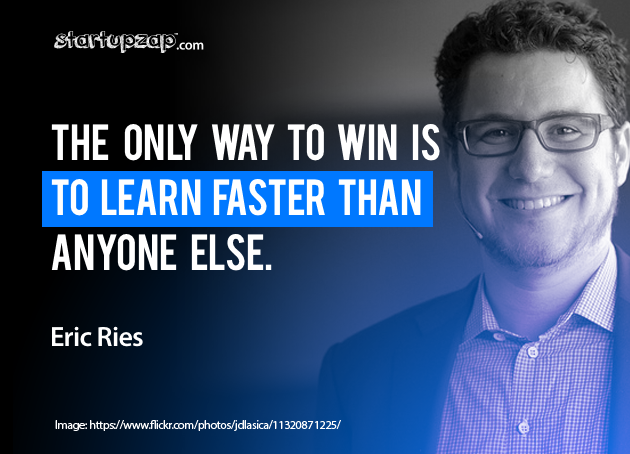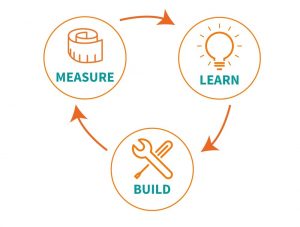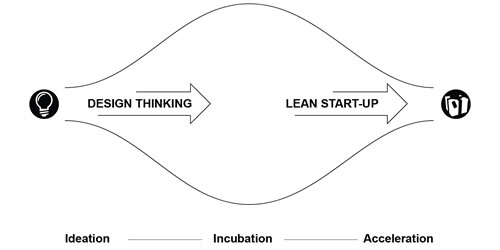Starting and running a small business or startup is an exhilarating journey filled with opportunities,…
When to apply Design Thinking and/or Lean Startup

Design Thinking and Lean Startup are part of the innovation portfolio. These methodologies are being used by corporates as well as startups to structure and de-risk their innovation activities. Inspired by success stories such as Uber and Airbnb companies are increasingly looking to Design Thinking and Lean Startup for answers. To effectively solve problems, it is essential for a firm understand when to apply either Design Thinking or Lean Startup. Or both.
Lean Startup
The Lean Startup, a term first used by Steve Blank, is best defined as a blueprint for how to run a startup. The Lean movement was then made popular by Eric Ries with his book The Lean Startup. In essence, the goal is to find the product-market fit by moving a Minimum Viable Product (MVP) through the Build-Measure-Learn process loop.
 When designing a new product and applying the lean methodology teams start by building a minimum set of features that satisfy early users – the so called MVP.
When designing a new product and applying the lean methodology teams start by building a minimum set of features that satisfy early users – the so called MVP.
Teams then test the assumptions they made about key features early-on with users and measure the data they acquire from experiments. In that way, evidence-based decisions can be made about the next stages that the product should be moving in. This process is repeated until a product-market fit is obtained.
Design Thinking
Design Thinking is an approach to problem-solving that results in solutions that people want. You should always start by building empathy with the people you are building a product/service for. Not research, not guessing, but finding out for yourself and asking hay and how. A range of methods from anthropology, sociology and psychology are used to gain insights into human behaviour, to enable a team to come to a clear understanding of who the user is and what their needs are. No engineering, no coding.
 Once you have empathy with the user, you then define and prioritize users most pressing problems and come up with relevant ideas to solve them. Ideas are then translated into rudimentary prototypes and presented to users. A prototype contains a minimum set of features (sounds like the MVP stage in Lean Startup right) that are tested in a continuous feedback loop (just like the build-measure-learn loop in Lean Startup).
Once you have empathy with the user, you then define and prioritize users most pressing problems and come up with relevant ideas to solve them. Ideas are then translated into rudimentary prototypes and presented to users. A prototype contains a minimum set of features (sounds like the MVP stage in Lean Startup right) that are tested in a continuous feedback loop (just like the build-measure-learn loop in Lean Startup).
Lean Startup Value
Both methods direct you to a prototype (in Design Thinking) or MVP (in Lean Startup) through a test-and-learn cycle. The key assumption being that using such a process is the best way to gain insight with the user. In this stage, the Lean Startup provides added value over Design Thinking by providing practitioners with a framework and actionable metrics (metrics that tie specific and repeatable actions to observed results).
Design Thinking Value
Design Thinking, in contrast, starts by empathizing with customers, defining their most pressing issues and based on this input, coming up with a range of relevant ideas. These steps are taken before the development of a prototype, hopefully reducing the risks involved with taking new innovations to your market. Examining peoples’ interest before investing in development. In that respect, Design Thinking is most valuable in the earliest stages of an innovation project.
How do Design Thinking and Lean Startup relate?
There is a division between ‘problem space’ & ‘solution space’ as defined by Dan Olsen in the Lean Product Playbook. This contrast offers us an alternative way of thinking about the Lean Startup and Design Thinking, as parts of a larger product/service innovation strategy.
Problem Space
The Problem Space is where the users and their needs exist. Needs are defined either as gaps in usability or as an absence of meaning. Successful innovations fill these gaps in either usability or providing meaning for users where it was absent. This could be a change to a brand, or service delivery component – not necessarily a new product. Design Thinking principally adds value in the problem space.
Solution Space
The Solution Space is where products and experiences that fulfil users’ needs occur. Lean Startup lives entirely in the Solution space along with other value-capturing methodologies such as Six Sigma & Agile.
Moving from Design Thinking (your Problem Space) to Lean Startup (your Solution Space)?
The challenge for innovation managers and product owners lies in working out when to move from Design Thinking to Lean Startup – from Problem to Solution. As a general rule, you need a certain amount of customer validation about the problem you are solving. Of course, the exact moment when each element can be considered ‘validated’ is individual and the team and budgets involved.
Lean Startup and Design Thinking Can Co-Exist!
Design thinking and Lean Startup are two parts of a wider innovation strategy. They are complementary and provide straight forward approach for practical innovation management across industries.
The central benefit of Design Thinking lies in the discovery of user needs, problems and the openness to a wide variety of ideas. However in some industries this can be difficult to achieve – and you need the right mix of skills and attitudes to do this well. We use and value both methodologies in our approach Startup Innovation to develop sustainable businesses.
Summary
- Keep the problem <> solution space aspect in mind. Don’t be afraid to keep in foot in both camps as you develop new products.
- Move into the Solution Space, applying Lean Startup, when you have validation about the problem you are trying to solve.
- Very early on, consider your company portfolio and strategic fit. If you are an intrapreneur, avoid spending time and energy on a project that will eventually be killed off.



